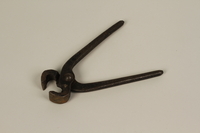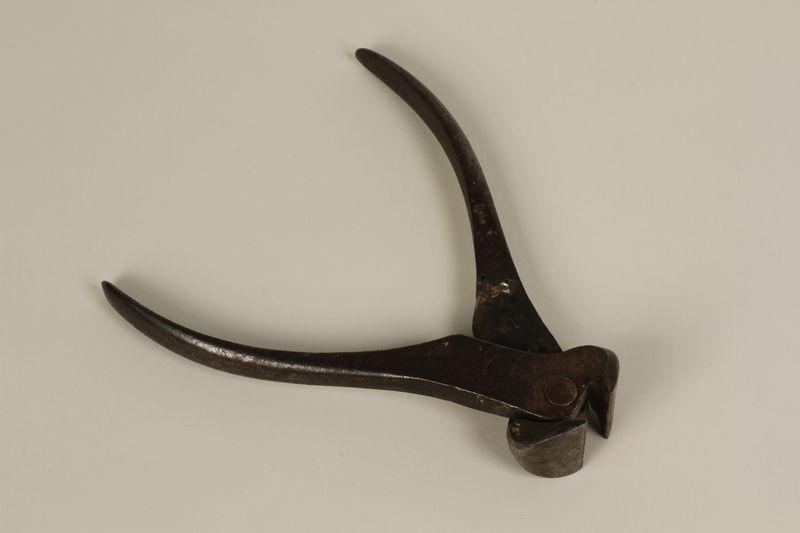Overview
- Brief Narrative
- Large pair of C Seelbach Co. gripper pliers brought to the United States on October 3, 1940, by Berthold Baer, his wife Hilde, and son Hans (later Larry) from Frankfurt, Germany, via the Netherlands and England. Berthold was a bank official in Frankfurt when Adolf Hitler was appointed chancellor of Germany in 1933. By 1938 the German authorities had passed many anti-Semitic laws that isolated and restricted the everyday lives of the Jews. Berthold was legally barred from working and during Kristallnacht on November 9, he was arrested. On November 13 he was imprisoned for two weeks in Buchenwald concentration camp. In February 1939, Berthold and his family left Germany. On route, the family was stopped at the German border and their valuables were taken from them. They traveled to the Netherlands, then England and went on to the United States in 1940. In the fall of 1942 Berthold’s sisters and their husbands were arrested and deported to Theresienstadt ghetto-labor camp and Treblinka killing center where they were murdered. On March 18, 1943 Hilde’s mother Clara was deported to Theresienstadt. Hilde’s brother Werner, a school director who aided in the escape of over 100 students and faculty from Germany in 1939, was arrested with his wife and young son on October 23, 1944. They were deported to Theresienstadt, and later, Auschwitz concentration camp, where they were killed. Clara was the only member of the Baer’s extended family to survive the Holocaust.
- Date
-
emigration:
1939 February 02
- Geography
-
manufacture:
Germany
use: Germany
use: United States
- Credit Line
- United States Holocaust Memorial Museum Collection, Gift of John L. Baer
- Markings
- front, joint, outside, engraved : C. SEELBACH Co. GERMANY
- Contributor
-
Subject:
Berthold Baer
Subject: John L. Baer
Manufacturer: C. Seelbach Co.
- Biography
-
Berthold Baer was born on February 4, 1894 in Seligenstadt, Germany, to a Jewish couple, Julius and Esther Bender Baer. He had two older sisters, Else (b. 1888) and Helene (Lenchen) (b. 1887). Lenchen was married to Julius Simons (b. 1882), who owned a leather and shoe store in Eltville, Germany. Else was married to Emil Adler (b. 1879) who owned a butcher shop in Friedberg, Germany. Berthold served in the Prussian infantry during World War I. In 1915, he was injured in battle and awarded the Iron Cross for his actions. Later, Berthold married Hilde Simon (b. 1902). Hilde’s parents were Max and Clara Blank Simon (b. 1871). Hilde had a brother, Dr. Werner Simon (b. 1903) who married Eva Lowenthal (b. 1916), they had a son, Dan (b. 1940). Berthold and Hilde had a son, Hans Lothar Baer (later John Larry). Berthold was a bank official and the family lived in a well furnished apartment in Frankfurt, Germany.
In 1933, Adolf Hitler was appointed chancellor of Germany. The German authorities passed many anti-Semitic laws that isolated and restricted the everyday lives of the Jewish community. By 1938, Jews were no longer allowed to teach, hold civil service professions, or attend school. Their property was confiscated, their businesses were closed and their movements restricted. Berthold was no longer allowed to work, and Nazi party members confiscated numerous paintings, silver baskets, and other valuables from the Baer’s apartment. During Kristallnacht on November 9th, Berthold was arrested by the authorities and transported to Buchenwald concentration camp, arriving on November 13. He was issued prisoner number 10226. Due to his previous military service for Germany during World War I, he was released on November 30.
Berthold’s brother in law, Werner was the director of the ORT vocational school in Berlin. The ORT is an international Jewish educational group with schools that emphasize vocational studies. Werner worked with the leadership of the British ORT to persuade the German authorities into awarding exit permits for the students and faculty. He traveled to the Gestapo offices in Berlin several times to consult with their officers and convinced them that the Berlin ORT School would be relocated to Leeds, England. Eventually Adolf Eichmann signed off on the paperwork allowing the students and teachers to immigrate to England to attend the nonexistent ORT School. On August 27, 1939, 104 students, 7 teachers, and their wives boarded a train in Charlottenburg, Germany, and reached England via Holland. The remaining students and faculty were scheduled to leave on September 3. However, on September 1, Germany invaded Poland and England declared war on Germany. As a result Werner, the students, and faculty remained in Germany.
On February 2, 1939 Berthold and his family were granted visas to emigrate from Germany. At the Dutch border, German authorities confiscated the valuables that that family had brought with them, including Berthold’s stamp collection. Berthold and his family travelled from the Netherlands to England, and in September 1940, they sailed on the SS Scythia out of Liverpool and arrived in New York on October 3, 1940. Among Berthold and Hilde’s families, only Berthold’s mother in law Clara survived the Holocaust. On July 26, 1941, Julius was deported to Theresienstadt ghetto-labor camp in Czechoslovakia, he was released, and then deported back to Theresienstadt the first week of September 1942, where he was murdered on November 9, 1943. On August 28 1942, Lenchen was deported to Theresienstadt, where she was murdered on April 7, 1944. On September 30, 1942, Emil and Else were deported to Treblinka killing center in Poland where they were murdered. On March 18, 1943, Clara was deported to Theresienstadt. On February 5, 1945, Clara, was one of 1200 prisoners that were released and taken by train to Switzerland. The Schutzstaffel (SS) leadership, as a token of good faith, had ransomed the prisoners for 5 million Swiss francs, paid for by various Jewish organizations. On June 16, 1943, Werner and his family were arrested by the Gestapo in Berlin and deported to Theresienstadt. On October 23, 1944, they were deported to Auschwitz killing center on transport Et/96, transport numbers 1516, 1517, and 1518, and murdered. Berthold and his family lived in New York for a time and then moved to Bucks County Pennsylvania. He worked at the Stoll Metal Corporation and later as a business manufacturer. His son Hans Americanized his name to John and served as an engineer with the U.S. Army for 30 years. He married Shirley Resnick and had three children. John Larry Baer, aged 86, died on December 27, 2014. Berthold Baer, aged 69, died on October 15, 1963 in Levittown, Pennsylvania.
Physical Details
- Language
- English
- Classification
-
Tools and Equipment
- Category
-
Hand tools
- Object Type
-
Nippers (aat)
- Physical Description
- Dark silver colored, metal gripper pliers formed from two nearly identical pieces joined together, each with a smooth, curved handle that tapers to a rounded end. The handle exterior is rounded and the interior is flat, with a four sided, flat topped stop on each. The handle widens and flattens out, forming a long, straight joint, where the pieces are attached with a rivet. Each side of the joint thickens and curves to form a C shaped head. The two sides of the head meet at their long, horizontal, tips which taper down to rough, worn, beveled edges. A circular maker’s mark is engraved on the outside of the joint. The joint and head are slightly rusty and there are small scratches and chips throughout from use.
- Dimensions
- overall: Height: 7.125 inches (18.098 cm) | Width: 2.000 inches (5.08 cm) | Depth: 1.375 inches (3.493 cm)
- Materials
- overall : metal
Rights & Restrictions
- Conditions on Access
- No restrictions on access
- Conditions on Use
- No restrictions on use
Keywords & Subjects
Administrative Notes
- Legal Status
- Permanent Collection
- Provenance
- The pliers were donated to the United States Holocaust Memorial Museum in 2011 by John Baer, the son of Berthold Baer.
- Record last modified:
- 2023-02-23 16:44:29
- This page:
- https://collections.ushmm.org/search/catalog/irn43727
Also in Baer family collection
The collection consists of two gripper pliers, correspondence, documents, photographs, and a manuscript relating to the experiences of Berthold Baer, his family, and extended family in Germany and the United States before, during, and after the Holocaust. Some of these materials may be combined into a single collection in the future.
Date: 1914-1940

Gripper pliers brought to the US by a German Jewish refugee
Object
Small pair of gripper pliers brought to the United States on October 3, 1940, by Berthold Baer, his wife Hilde, and son Hans (later Larry) from Frankfurt, Germany via the Netherlands and England. Berthold was a bank official in Frankfurt when Adolf Hitler was appointed chancellor of Germany in 1933. By 1938 the German authorities had passed many anti-Semitic laws that isolated and restricted the everyday lives of the Jews. Berthold was legally barred from working and during Kristallnacht on November 9, he was arrested. On November 13 he was imprisoned for two weeks in Buchenwald concentration camp. In February 1939, Berthold and his family left Germany. On route, the family was stopped at the German border and their valuables were taken from them. They traveled to the Netherlands, then England and went on to the United States in 1940. In the fall of 1942 Berthold’s sisters and their husbands were arrested and deported to Theresienstadt ghetto-labor camp and Treblinka killing center where they were murdered. On March 18, 1943 Hilde’s mother Clara was deported to Theresienstadt. Hilde’s brother Werner, a school director who aided in the escape of over 100 students and faculty from Germany in 1939, was arrested with his wife and young son on October 23, 1944. They were deported to Theresienstadt, and later, Auschwitz concentration camp, where they were killed. Clara was the only member of the Baer’s extended family to survive the Holocaust.
Berthold Baer papers
Document
Documents, correspondence, photographs and album illustrating the experiences of Berthold and Hilde Baer and their son Hans Lothar in Germany surrounding WWII in Germany. Included are military documents for Berthold's WWI service, photographs and albums of pre-war Germany and documents and correspondence surrounding their immigration to the United States via London, England. Documents, photographs and correspondence also illustrate Werner Simon (Hilde's brother) and his wife Eva and their son Daniel, all of whom were killed and information concerning Clara Simon (Werner and Hilde's mother) who was liberated in Theresienstadt.




